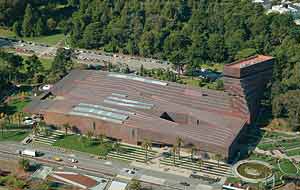One Project, but Many Seismic Solutions
Learning Objectives:
- Discuss the earthquake-resisting technologies used in the two structures the museum comprises.
- Describe the components of this project's base-isolation system.
- Explain why base isolation was used for the exhibition spaces.
Credits:
The designers of San Francisco's de Young Museum, taking their cue from its idyllic setting, have brought the surrounding Golden Gate Park right up to, and practically inside of, the new $202 million building, which opened in October 2005. Its copper sheathing, perforated and dimpled to mimic the way light filters through foliage, is already beginning to take on varied hues. The project's 144-foot-tall tower cants and twists as it rises above the park's tree canopy, providing views of the city and San Francisco Bay.
Hidden but no less significant than these contextual moves by the primary design architect Herzog & de Meuron are the project's seismic features. Few buildings incorporate such a diversity of earthquake-resisting strategies. The exhibition spaces occupy a base-isolated, three-story structure made up of three interconnected and roughly parallel "fingers," each a different shape but about 420 feet long and 75 feet wide, and separated by planted courtyards. Although the contiguous nine-story tower sits on a fixed base, its unusual shape required major earthquake engineering finesse. Even the tower's skin demanded its own seismic solution.
It is not difficult to appreciate why seismic engineering played such a prominent role in the design of the de Young, which occupies a site only 4.7 miles from the San Andreas Fault. It replaces six adjoining buildings constructed on the same site between 1916 and 1955 and closed since 2000 after suffering damage 11 years earlier in the Loma Prieta Earthquake [record, November 2005, page 107]. The institution's first home, built in 1894 also on the Golden Gate Park site, was significantly damaged in the earthquake of 1906.
The seismically sensitive location and the need to protect the de Young's delicate and eclectic collections prompted the client, the not-for-profit Corporation of the Fine Arts Museums, which served as developer of the project for the city, to require base isolation for the low-rise building housing the galleries. Because these dynamic connections at the base of columns minimize transfer of an earthquake's ground motion to the steel-framed structure above as well as to its contents, the de Young's curators can brace or anchor the artifacts conventionally and have more freedom with temporary exhibitions. "The aim was to reduce the level of floor acceleration so that the art will ‘feel' little vibration in an earthquake," says Bret Lizundia, a principal at Rutherford & Chekene, San Francisco, the project's structural engineer.
|
The use of base isolation not only provided flexibility for the display of art, but also allowed freedom with the design of the superstructure. A directive from the client for as many open spaces as possible resulted in an irregular column grid, trusses as deep as 20 feet, and long clear spans. The longest is more than 90 feet and bears on the back span of a cantilevered plate girder. "I can't point to anything in particular we couldn't have done without base isolation, but we were able to use less expensive and less complicated details," says Lizundia.










